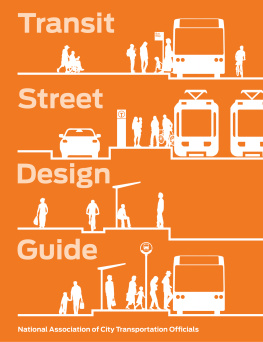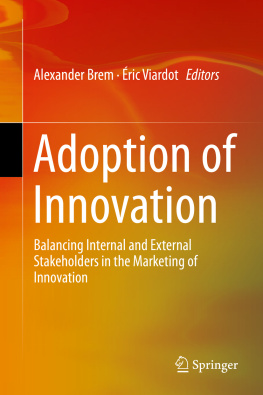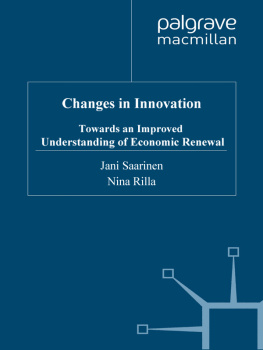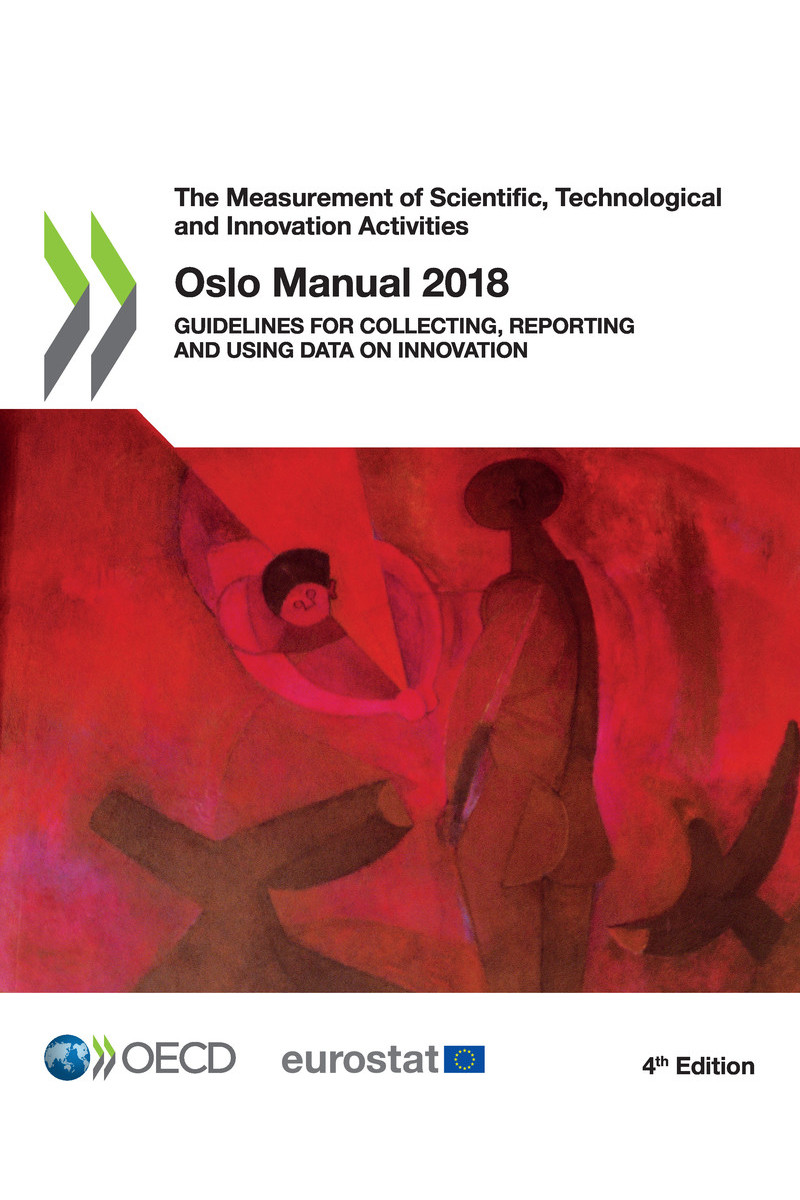The Measurement of Scientific, Technological and Innovation Activities
Oslo Manual 2018 Guidelines for Collecting, Reporting and Using Data on Innovation, 4th Edition
Please cite this publication as:
OECD/Eurostat (2018), Oslo Manual 2018: Guidelines for Collecting, Reporting and Using Data on Innovation, 4th Edition , The Measurement of Scientific, Technological and Innovation Activities, OECD Publishing, Paris/Eurostat, Luxembourg.
https://doi.org/10.1787/9789264304604-en
Metadata, Legal and Rights
ISBN: 978-92-64-30455-0 (print) - 978-92-64-30460-4 (pdf) - 978-92-64-01558-6 (HTML) - 978-92-64-01467-1 (epub)
DOI: https://doi.org/10.1787/9789264304604-en
Series: The Measurement of Scientific, Technological and Innovation Activities
ISSN: 2413-2756 (print) - 2413-2764 (online)
European Union
Print
Catalogue number: KS-01-18-852-EN-C
ISBN 978-92-79-92581-8
PDF
Catalogue number: KS-01-18-852-EN-N
ISBN 978-92-79-92578-8
This work is published under the responsibility of the Secretary-General of the OECD. The opinions expressed and arguments employed herein do not necessarily reflect the official views of OECD member countries or those of Eurostat or the European Union.
This document, as well as any data and any map included herein, are without prejudice to the status of or sovereignty over any territory, to the delimitation of international frontiers and boundaries and to the name of any territory, city or area.
The statistical data for Israel are supplied by and under the responsibility of the relevant Israeli authorities. The use of such data by the OECD is without prejudice to the status of the Golan Heights, East Jerusalem and Israeli settlements in the West Bank under the terms of international law.
Photo credits: Prometheus bringing fire to mankind, fresco mural painting by Rufino Tamayo, 1958. Original work on display at UNESCO, Paris. Photo reproduced with permission from UNESCO and authors heirs, depicted in full in the Acknowledgements section. D.R. Rufino Tamayo/Herederos/Mxico/2018/Fundacin Olga y Rufino Tamayo, A.C. All rights reserved UNESCO Photo UNESCO/J.C.Bernath.
Corrigenda to OECD publications may be found on line at: www.oecd.org/publishing/corrigenda .
OECD, European Union, 2018
You can copy, download or print OECD content for your own use, and you can include excerpts from OECD publications, databases and multimedia products in your own documents, presentations, blogs, websites and teaching materials, provided that suitable acknowledgement of OECD as source and copyright owner is given. All requests for public or commercial use and translation rights should be submitted to .
Foreword
Addressing the current and emerging economic, social and environmental challenges requires novel ideas, innovative approaches and greater levels of multilateral co-operation. Innovation and digitalisation are playing an increasingly important role in virtually all sectors and in the daily lives of citizens around the world. As such, policy makers are placing the innovation imperative at the centre of their policy agendas.
The design, development and implementation of policies, however, is fraught with difficulty and even more so when international co-ordination is required. Innovation has often been regarded as too fuzzy a concept to be measured and accounted for. The OECD Frascati Manual opened the way for measuring one key dimension of science, technology and innovation so that, nowadays, investment in research and development R&D is systematically encouraged and monitored around the world. However, policymaking today is still largely focused on what is easier to measure. There is, therefore, an urgent need to capture how ideas are developed and how they can become the tools that transform organisations, local markets, countries, the global economy and the very fabric of society.
In 1991, the city of Oslo witnessed the first agreement within the global community of practitioners in the OECD Working Party of National Experts on Science and Technology Indicators on how to conceptualise and measure business innovation. These guidelines became known as the Oslo Manual , which was published and put to the test with the support of the European Union. The fast adoption and diffusion of the manuals proposals, both within and beyond the OECD and the EU, are a clear indication of the value of this initiative; in fact, innovation surveys covering more than 80 countries have been carried out thus far.
Moreover, the OECD and Eurostat have jointly led further revisions of the manual to extend the scope and increase the robustness of the data collected according to the Oslo guidelines. These revisions have been based on the experience gained from collecting data on innovation in OECD member and partner countries.
This fourth edition of the Oslo Manual takes account of major trends such as, the pervasive role of global value chains; the emergence of new information technologies and how they influence new business models; the growing importance of knowledge-based capital; as well as the progress made in understanding innovation processes and their economic impact. Its guidance seeks to contribute to measuring the process of digital transformation and thus supports the goals of the OECDs Going Digital initiative.
The manual is a truly international resource benefitting from inputs by UNESCO, the World Bank and a number of regional development banks, who, like the OECD, are strongly committed to developing an evidence base to support investments in innovation and promote economic and social development. The 2018 edition is relevant for economies worldwide, regardless of their levels of economic development, and supports the assessment of the Sustainable Development Goals (SDGs). The manual rises to the challenges of being globally relevant as set out by the G20 at its 2016 summit in Hangzhou (China); and continuing to improve measurement systems to better capture the key features of science, technology and innovation as stated in the Declaration of Science and Innovation Ministers Meeting in Daejeon (Korea) in 2015.
For the first time, the Oslo Manual provides a common framework for measuring innovation in a more inclusive manner across the economy, in government, in non-profit organisations and in households. This provides a path for realising many of the proposals put forward at the OECD Blue Sky Forum held in Ghent (Belgium) in 2016. For example, the inclusion of a new chapter in the manual focuses on the use of innovation data for constructing indicators and conducting analysis and evaluation.
The Oslo Manual has earned a pre-eminent place in the family of continuously evolving instruments devoted to the definition, collection, analysis and use of data related to science, technology and innovation. As a statistical manual, it represents a meeting point between users needs for practical concepts, definitions and evidence on innovation, and the expert consensus on what can be robustly measured. Conceived as an open, voluntary standard, the Oslo Manual seeks to inspire dialogue, encourage new data collection efforts and experimentation.
As highlighted by the OECD Innovation Strategy, better measurement of innovation and its impact on economic growth, sustainability and inclusiveness is key to fulfilling the promise of better co-ordinated innovation policies in the digital era. The OECD has long argued for a whole-of-government approach to innovation policy and has stressed the importance of understanding the complex array of factors that influence innovation and the way it impacts our societies, anticipating and addressing their unintended outcomes. The Oslo Manual represents an extremely valuable additional tool for a wide range of innovation experts and policy practitioners worldwide.
















